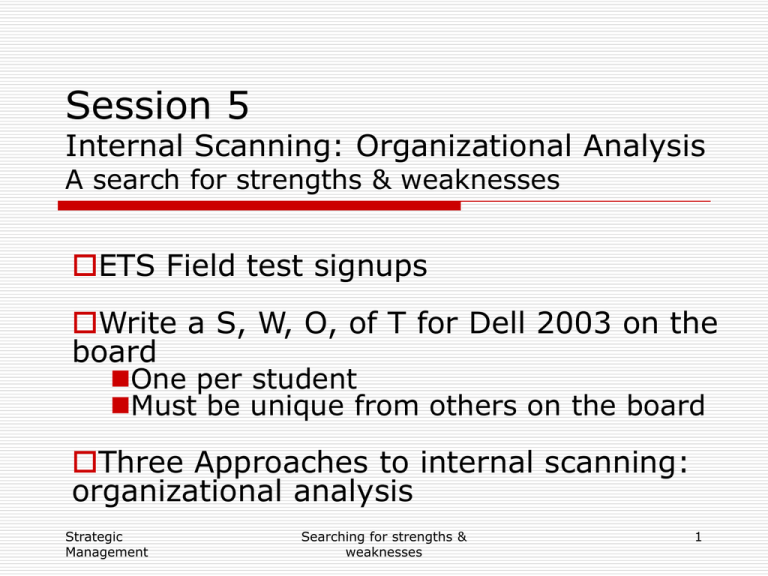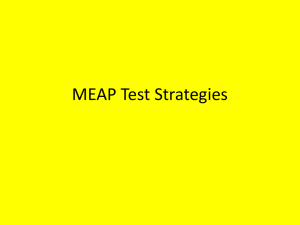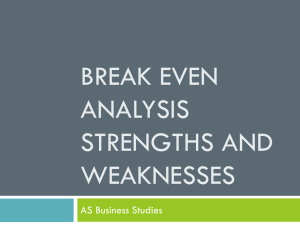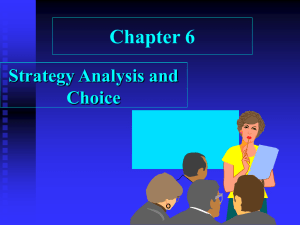Document
advertisement

Session 5 Internal Scanning: Organizational Analysis A search for strengths & weaknesses ETS Field test signups Write a S, W, O, of T for Dell 2003 on the board One per student Must be unique from others on the board Three Approaches to internal scanning: organizational analysis Strategic Management Searching for strengths & weaknesses 1 Industry Analysis (Porter) Other Stakeholders Suppliers Strategic Management Relative Power of Unions, Government, Etc. Potential Entrants Threat of New Entrants Industry Competitors Bargaining Power Of Buyers Buyers Bargaining Rivalry Among Existing Firms Power Of Suppliers Threat of Substitute Products or Services Searching for strengths & Substitutes weaknesses 2 Wrapping up from last session Identifying Opportunities and Threats using Porter’s industry analysis model What opportunities & threats does relative power of Porter’s forces lead to? Buyers power Suppliers power Other stakeholders power Substitutes—alternative ways to satisfy need Rivalry among existing firms Potential new entrants Strategic Management Opportunities Threats Searching for strengths & weaknesses 3 Session 5: Internal Scanning: Organizational Analysis A search for strengths & weaknesses Development of Opportunities and Threats Environmental analysis Areas of concern Issues and priorities O & T Industry analysis (Porter model) Areas of concern O & T Development of Strengths & Weaknesses Competencies and resource-based analysis S & W Value chain analysis S & W Scanning internal resources & capabilities S & W Analyzing strategic factors Generating alternative strategies Selecting & implementing chosen strategy Strategic Management Searching for strengths & weaknesses 4 Competencies—a path to competitive advantage Core competencies: things the organization can do exceedingly well Distinctive competencies: core competencies that are superior to the competition Sustainability of distinctive competencies depends on Durability Imitability: transparency, transferability, and replicability Strategic Management Searching for strengths & weaknesses 5 What strengths and weaknesses are revealed by this analysis? Resource-based analysis Identify resources/capabilities in terms of strengths & weaknesses Identify core competencies, things they can do very well Identify distinctive competencies, things they do better than competition (competitive edge) Assess sustainability: durability imitability (transparency, transferability, replicability) Identify capability/resource gaps Define strategies Define plans to address resource/capability gaps Strategic Management Searching for strengths & weaknesses Apply the resource-based approach to determine the6 firm’s competitive advantage. Value chains (external) Industry value chain (Fig. 4.2)—show activity flow from raw materials to consumer Corporate value chain—examines How inputs are converted to outputs Processes by which value is added ”Differences among competitor value chains are a key source of competitive advantage.” Porter Strategic Management Searching for strengths & weaknesses 7 Corporate value chain analysis (internal) Examines internal operations to understand which parts add value Only value-adding parts contribute to above average returns (profits) Seeks to identify multiple means to implement chosen business strategy See Nordstrom’s example Strategic Management Searching for strengths & weaknesses 8 Which cells are strong? What issues, strengths, and weaknesses are revealed by this analysis? Which are weak? Which offer competitive opportunities? Support Activities The corporate (internal) value chain Firm infrastructure Human resource management Technology Development Procurement MarketOutServing Inbound Operabound ice Logistics tions and Logistics sales Strategic Management Searching for strengths & weaknesses Primary Activities 9 Functional strategy The approach a function takes to support business strategy & achieve objectives The path chosen to define and assure effectiveness of the function Strategic Management Searching for strengths & weaknesses 10 SWOT analysis & Alternative Strategies STRENGTHS – S WEAKNESSES - W Internal See description of each cell in H&W Figure 5.2 External OPPORTUNITIES – O THREATS - T SO STRATEGIES ST STRATEGIES WO STRATEGIES WT STRATEGIES Word and PowerPoint versions of this form are available on Assignments and Forms web page Strategic Management Searching for strengths & weaknesses 11 Assignment for next time: Developing Strategic Alternatives Study H&W Ch 5, Section 5.4 Business Strategies Readings in Vista on: Netflix, Southwest Airlines, Dell 2003, Dell 2005, and Dell 2006 Value chain analysis Illustrate the development of each strategy cell, e.g., SO, WO, ST, WT (Reference H&W, Fig 5.2). (TOWS forms are available from the course web site in Assignments and Forms section.) One entry per strategy cell is sufficient. a. State S and O b. State SO strategy that follows from the S and O c. Include results in a SWOT or TOWS slide Repeat above steps for WO, ST, and WT. A different firm can be used for each, but be sure to identify the firm. Submit a paper copy at the beginning of class. Be prepared to use the value chain model and distinctive competency concepts to justify each strategy presented. Strategic Management Searching for strengths & weaknesses 12 Checklist for stating alternative strategies Begin with an action verb--which helps us keep an present future focus Build on intersecting internal/external forces Apply learned concepts Assure strategy has value Consider if strategy is feasible and realistic Consider if strategy will give a good return on resources required Strategic Management Searching for strengths & weaknesses 13 Analysis concepts Strategy: purpose, formulation vs. implementation & elements of each; generic types Strategic Management: process & sub tasks, strategic decision making, top management’s role Hierarchy of strategy: corporate, business, functional Organizational effectiveness: goal, RB, IP, stakeholders Objectives vs. goals: criteria to distinguish; requirements of objectives Analyzing external environment: societal & task; how to do it, Porter model, Analyzing internal environment Resource-based: core & distinctive competencies, elements of sustainability Value chain Scanning internal resources: structure, culture, functional capabilities Strategic audit (appendix 11C) SWOT and building a TOWS matrix of alternative strategies Corporate strategy: directional (growth, stability, retrenchment), portfolio analysis, parenting Functional strategies: outsourcing, marketing, finance, R&D, operations, HR, IT 3 tests of distinctive competency Financial performance and condition Implementing strategy: role of programs, budgets, procedures Strategic Management Searching for strengths & weaknesses 14 H&W Fig. 5.4 describes cell contents Generating strategic alternatives Analyze your S W O T To set strategies SO WO ST WT Strategic Management O OPPORTUNITIIES S W STRENGTHS WEAKNESSES SO WO STRATEGIES STRATEGIES T ST WT THREATS STRATEGIES STRATEGIES Searching for strengths & weaknesses 15







